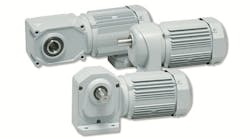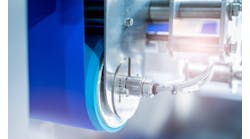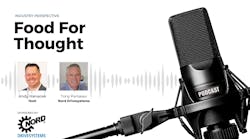Equipment is powered by motors. And increasingly, so is equipment innovation.
Improvements in electric motors, and in the drives and controls that regulate them, are enhancing the versatility and flexibility of conveyors and other food plant equipment. As they become more powerful and more capable of handling varied loads and tasks, they open new possibilities of economy, quick response and better overall performance.
One of the most significant trends has to do with conveyors. For a long time, running them at a single speed was the only option. Even when there was nothing for them to carry, they often were kept running because that was more energy-efficient than repeatedly stopping and starting them. If varied speeds were absolutely required, to accommodate changes in products or packages, that had to be achieved through mechanical means, like shifting pulleys to stretch a power transmission belt.
In many food and beverage plants, that’s still the case. But increasingly workhorse motors, the kind capable of powering conveyors, are capable of handling different speeds, even starting and stopping. This is because of improvements in the drives that feed them.
AC-DC
Most motors that power food plants run on alternating current (AC), because they’re cheaper, safer and more durable than direct-current (DC) motors. But AC motors basically are designed to run at only one speed. To vary their speed, the electric current that powers them has to pass through a drive that alters its frequency – the number of times per second that it pulses, or “alternates.”
These variable-frequency drives (VFDs) are relatively complex, comprising a capacitor that stores the alternating current and an array of circuits that changes the frequency. (Technically, a VFD converts incoming alternating current into direct current, which it “fools” the motor into thinking is AC by outputting it at the required number of cycles per second.)
This complexity made early models fragile and hot to operate, requiring cooling fans and adequate ventilation. These factors made VFDs problematic for food plants, especially in tough environments with high temperatures, vibration, moisture or dust.
To accommodate these conditions, VFDs sometimes are enclosed in protective cabinets, often at a considerable distance from the motors they power. But this presents another problem: connecting the drive to the motor. The power has to pass through a cable, and when it’s a long way between the drive and the motor, cabling becomes complicated and expensive. This is especially true for motors in high-load applications, because cables that can carry the necessary amperage are thicker and costlier.
However, this situation is improving because VFDs are improving. They’re becoming smaller, lighter and more durable, enabling them to be installed much closer to the motors they power and control.
“I’ve seen through the years, [VFDs have] gotten smaller and able to handle more parameters and acting better,” says Allen Overmyer, senior technical advisor with Rovema NA (www.rovema-na.com), a manufacturer of baggers and other packaging equipment. “It’s just like any technology.”
The intelligent drum motor from VDG (Van Der Graaf) features a drive and control packaged right next to the motor.
In some cases, VFDs can be put literally in the same package as the motors they power and control. That’s what VDG (Van der Graaf) is doing with its new intelligent drum motor. Designed, like all drum motors, to pull a conveyor, it integrates an AC motor, a VFD and a controller into one unit.
“It saves on the install, and it saves on the cost of wiring it,” says Rick Zander, VDG's business development manager (www.vandergraaf.com).
The need for varied speed
Using AC motors with variable speeds opens up new options for equipment design. Basically, it gives the AC motor the capacity to do positioning and vary velocity. This makes them suitable for applications such as conveyors that have to change speeds to sync with processing or packaging equipment.
“Now most conveyor systems are smart,” says Mike Wagner, global OEM packaging segment manager for Rockwell Automation (www.rockwellautomation.com). “You have the ability to turn sections on and off. Even within one conveyor, you can speed up and slow down certain rollers, so you can turn a box or a carton.”
VFDs have this capacity because they make it easier and cheaper for a motor to get a conveyor moving, especially when there’s a heavy load sitting on it. They do so through their ability to ramp up the motor incrementally; a mono-speed motor, especially one that’s directly connected to standard current, will draw a surge of current. This not only adds to energy costs but wears on the motor’s mechanics, winding and insulation.
“If you put a VFD on there, that removes the mechanical and electrical stress associated with starting that motor,” says Mark Harshman, director of technical business development at Siemens (new.siemens.com).
VFDs have applications for equipment beyond conveyors. For instance, baghouse filters, used to treat air in dusty environments like bakeries, need varied airflow over their lives to be effective. If the flow through a new filter is too fast, particulates will embed themselves deep in the filter, lowering its effectiveness and useful life. If it’s too slow at the end of the filter’s lifecycle, the air won’t be properly filtered.
Most baghouses use a single-speed fan and regulate the airflow with vanes, but if the fan’s motor is fed through a VFD, it can run at whatever speed is required for a given stage of the filter’s life, Harshman says. This lowers the strain on the motor and extends its life.
Permanent improvement
The versatility of AC motors also has been increased by the advent of permanent-magnet (PM) motors. These feature magnets installed in the motor’s rotor (the rotating inner core, connected to the shaft) as an alternative to inducing a magnetic field in the rotor with electric current. PM motors are more expensive than induction motors but they offer more torque in a smaller package, giving them more startup power.
“When you go permanent-magnet, your flux density increases and the inertia goes down substantially versus a coil-wound rotor,” Wagner says. Harshman estimates that compressors and pumps can run 5-10 percent faster, at no additional operational cost, on PM motors compared with induction.
VDG’s intelligent drum motor uses permanent magnets. Zander says that, to get the torque it needs, an induction motor will draw up to twice its usual operational amperage at startup. A permanent magnet motor is instantly at speed upon turning on and stays at constant torque, he says: “You can speed it up and slow it down – the torque will be just the same.”
Internal permanent magnet motors bring more power into a smaller package. Photo: Brother International
Permanent magnets can be mounted on the outside or the inside of the rotor. The latter are known as internal permanent magnet (IPM) motors. Positioning the magnets in the rotor’s interior makes the motor even more efficient.
By using IPMs, Brother Gearmotors (www.brother-usa.com) makes its products 23 percent smaller and run 24 percent cooler than standard AC motors, says company vice president Matthew Roberson. They can also run without a fan, which is important for dusty environments.
Using IPMs helps Brother make its gearmotors smaller, more efficient and power-dense, Roberson says. Gearmotors, which package a motor together with a gearbox for transforming the motor shaft’s rotation into torque, have several advantages over most separate motor-gearbox combinations: They’re smaller and lighter, easier to mount, and more resistant to moisture and other contamination.
As motors and their related components become more sophisticated, they’re able to better handle the demands of increasingly sophisticated equipment, while offering greater efficiency and energy savings. Taking full advantage of their capabilities will help make everything powered by motors – which is to say, almost everything in the plant – work better.


